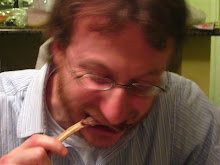 Homemade mayonnaise. Many posts on the subject, but not too many pictorials. So here's one.
Homemade mayonnaise. Many posts on the subject, but not too many pictorials. So here's one.It's likely one of the easiest emulsions to make, and no matter how much Harold McGee I read I'm still amazed every time I see two runny liquids whisked together to form a mixture thicker than the original two parts. Really, it's like alchemy.
Pictured above is egg yolk, Dijon mustard, Canola oil, and white wine vinegar. Pretty special on their own, but they work well together too. It's also a self-portrait.
 Above is the yolk, mustard, vinegar (lemon juice works well too), and some salt and pepper whisked together. It's the foundation.
Above is the yolk, mustard, vinegar (lemon juice works well too), and some salt and pepper whisked together. It's the foundation. At this point a good bit of oil has been added. You don't need to be as cautious as some say. Once the foundation is together I add a few drops of oil, whisk to incorporate, add a few more drops of oil, whisk to incorporate again, repeat, repeat, repeat . . . . As more oil is incorporated it can be added more liberally. While the adage "better a tired arm than a broken sauce" (or something like that) may be applicable, this isn't so bad. If it is use a food processor, but that takes the fun away. If it's not fun, buy Hellmann's.
At this point a good bit of oil has been added. You don't need to be as cautious as some say. Once the foundation is together I add a few drops of oil, whisk to incorporate, add a few more drops of oil, whisk to incorporate again, repeat, repeat, repeat . . . . As more oil is incorporated it can be added more liberally. While the adage "better a tired arm than a broken sauce" (or something like that) may be applicable, this isn't so bad. If it is use a food processor, but that takes the fun away. If it's not fun, buy Hellmann's. 
The completed mayonnaise. Rich and slightly yellow. Very good stuff, but I wouldn't keep it for more than a few days in the fridge. It takes flavorings well (it's a mother sauce after all, at least according to Escoffier) too.
And don't forget, when in doubt ask "What Would Julia (Child) Do?":
The maximum amount of oil one U.S. Large egg yolk will absorb is 6 ounces or 3/4 cup. When this maximum is exceeded, the binding properties of the egg yolks break down, and the sauce thins out or curdles. If you have never made mayonnaise before, it is safest not to exceed 1/2 cup of oil per egg yolk.
MASTERING THE ART OF FRENCH COOKING by Julia Child, Louisette Bertholle, and Simone Beck
And sorry about the grainy pictures.





2 comments:
I can never get my mayo to look like that! Ahh!!!
Someday... someday...
I have faith. After all, the Canadian has to dip his fries in something.
Post a Comment